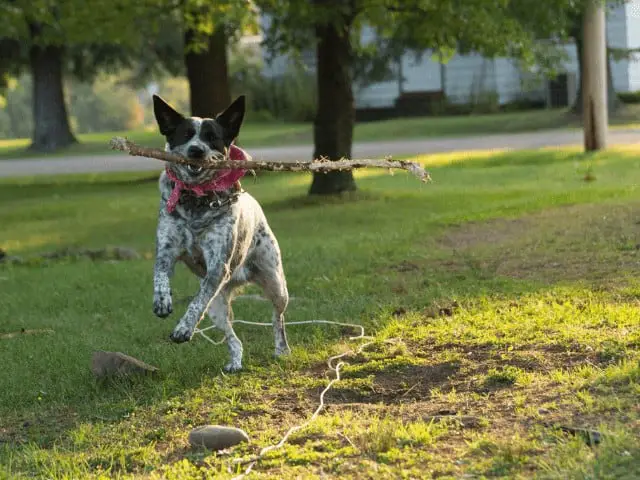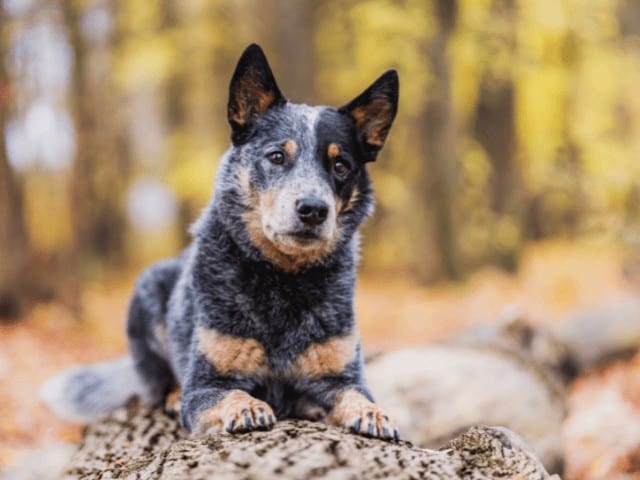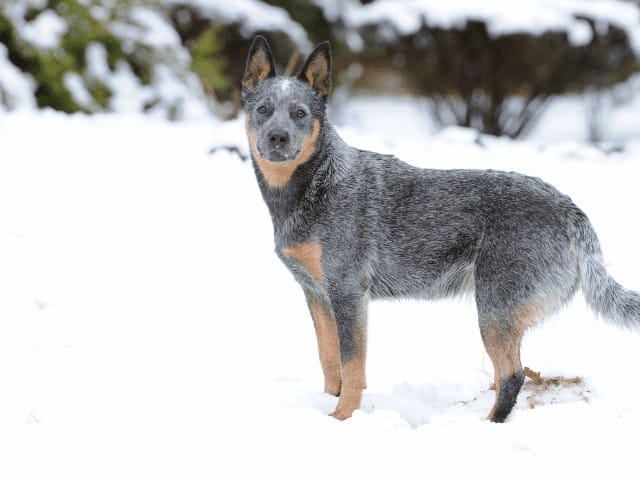Spending time outdoors has been proven to improve mental health and overall wellbeing and adding a canine companion to your travels is a great way to make hiking even more fun.
Just like people, dogs enjoy a variety of different activities and for hikers considering bringing a canine companion along for the adventure, it’s important to understand the breed and the best conditions for each individual dog.
Australian Cattle Dogs (sometimes referred to as a Blue Heeler or Red Heeler) are the perfect trail companion for avid hikers due to their high endurance, active lifestyle, and high intelligence. Understanding the breed, their health considerations, and what types of activities they excel at will create an ideal lifelong hiking buddy.
Health Considerations for Australian Cattle Dogs
Although Australian Cattle Dogs are a relatively healthy breed with an average lifespan of 12-16 years, they are prone to a few inherited conditions that may make hiking more challenging or impossible if undiagnosed or left untreated.
Hearing Impairment
One of the most common hereditary conditions affecting Australian Cattle Dogs is deafness. Although genetic testing can greatly reduce the risk of this condition, owners considering bringing an ACD into the home should ensure each dog has been thoroughly evaluated for hearing impairment before starting hiking.
Additionally, breeders and rescues should provide honest, transparent communication and openly share any health related paperwork with potential owners.
Australian Cattle Dogs that are affected by congenital hereditary sensorineural deafness are still able to hike, but the condition may prevent them from being able to hike off leash without a great deal of training.
are still able to hike, but the condition may prevent them from being able to hike off leash without a great deal of training.
Experienced dog owners working with professional trainers may be able to incorporate hand signals into a training regimen, but this requires a lot of patience, time, and commitment.
Bone & Joint Diseases
Australian Cattle Dogs are prone to developing bone and joint issues known as elbow or hip dysplasia . In affected dogs, irregular growth of the ball and socket joint causes the femur and the adjoining socket of the pelvis grow at disproportionate rates, resulting in laxity of the joint leading to degenerative joint disease or osteoarthritis
. In affected dogs, irregular growth of the ball and socket joint causes the femur and the adjoining socket of the pelvis grow at disproportionate rates, resulting in laxity of the joint leading to degenerative joint disease or osteoarthritis .
.
While appropriate breeding habits and health testing can rule out this condition in some dogs, it’s important to have a thorough veterinary exam before starting hiking and to stop if your dog displays any symptoms of pain during hiking such as limping, lethargy, or being slow or unable to rise after periods of activity.
For ACD puppy owners, feeding a balanced diet for each stage of life, adding joint support supplements, and avoiding strenuous exercise during adolescence can further decrease the odds of elbow or hip dysplasia later in life.
ACDs are a Highly Active Breed

Australian Cattle Dogs are a highly active breed that doesn’t just enjoy physical activity, but requires daily exercise to keep them healthy and out of trouble. As a member of the herding class, ACDs are compact and agile yet muscular dogs with boundless energy, making them the perfect hiking companion for trail runners or avid, long distance hikers.
Healthy, well-conditioned Cattle Dogs have high endurance and stamina when it comes to physical activity and can enjoy running up to 5 miles or hiking up to 15 miles on the trail. Additionally, they enjoy other physical activities like frisbee, fetch, and tug of war.
When hiking long distances, it’s important for owners to be prepared with plenty of supplies for their pup like adequate amounts of water, travel bowls, a collar with easy to read identification tags, a leash and harness, and training aids.
Australian Cattle Dogs Crave Mental Stimulation

This highly intelligent breed is infamous for their mischievous ways when not receiving adequate mental stimulation.
Australian Cattle Dog owners should be committed to providing their dog with daily mentally stimulating activities such as nosework, agility, herding, and obedience training, which can easily be incorporated into a hike.
Due to their high intellect, Australian Cattle Dogs are independent, headstrong dogs that require plenty of training before they can be trusted to hike off leash.
For young Australian Cattle Dogs or new rescue dogs, hiking is the perfect opportunity to work on leash manners and obedience while exposing them to a number of new and exciting stimuli to provide them with adequate socialization.
Australian Cattle Dogs are notoriously poor at adapting to new situations and the more they can be exposed to a variety of sights, sounds, and smells at a young age, the more well-adjusted they will be as adult dogs.
Specialized Training for Mental Stimulation in ACDs
Australian Cattle Dogs possess an immense work drive and one of the best ways to provide mental stimulation is by training them to perform a specific duty or job. One of the most popular and most important roles for ACDs in the hiking community is search and rescue training.
For members of the hiking community, search and rescue training for ACDs can provide a unique bonding experience while creating new relationships and providing an invaluable service to the community in times of need.
Australian Cattle Dogs Can Handle Any Kind of Weather

Whether you’re hiking in a winter wonderland or exploring a desert oasis, Australian Cattle Dogs make great hiking companions for both warm and cold weather hiking due to their double coat , which consists of a soft undercoat with a thicker outer coat that provides important temperature regulation in all types of weather.
, which consists of a soft undercoat with a thicker outer coat that provides important temperature regulation in all types of weather.
In the winter, the undercoat serves as natural insulation to keep pets warm, but in cases of more severe weather, owners should practice cold weather animal safety techniques.
When hiking in cold weather, it’s important to stay away from icy terrain, invest in canine hiking gear like snow boots and properly fitted winter coats, and ensure your dog is healthy before setting off on an adventure.
When on the trail, owners should monitor their Cattle Dog for signs of hypothermia and be prepared for emergency situations with supplies like extra water, dry blankets, medications, and emergency contacts.
and be prepared for emergency situations with supplies like extra water, dry blankets, medications, and emergency contacts.
In warmer climates, the double coat keeps pets insulated by holding air close to the body to help Australian Cattle Dogs stay cool in hot climates. Proper grooming techniques to keep the hair from getting matted will allow the double coat to function properly for temperature regulation and shaving should be avoided.
Additionally, ACD owners should follow warm weather pet safety techniques allowing plenty of rest on hot days, offering water frequently, and staying in shaded areas along the trail. A good rule of thumb when hiking in warm weather is if it’s too hot for you, it’s too hot for your dog and they should be left at home.
Australian Cattle Dogs Love to Swim
Australian Cattle Dogs make the perfect companion for hikers looking to add water activities into their excursions. This breed loves water in all forms, except for maybe a bath! When introduced to water at a young age, ACDs are ideal water dogs and excellent swimmers.
Whether they’re running through creeks along wooded trails or participating in dock diving, water sports are a great way to keep this active breed happy and healthy. Other water activities ACDs enjoy are paddleboarding, kayaking, rafting, boating, fishing, and more.
Camping with an Australian Cattle Dog
Australian Cattle Dogs can make excellent companions for hikers setting out on multi-day excursions or camping retreats. Due to their fiercely loyal nature and awareness of their surroundings, Blue Heelers make great alert dogs to keep themselves and their owners safe if any wildlife or unwanted intruders approach the campsite.
However, ACDs are generally wary of strangers and poorly or under socialized Cattle Dogs can pose a threat to other hikers approaching on the trail or at the campsite. Owners should spend time on proper socialization techniques at a young age to ensure their Australian Cattle Dog is well adjusted and adaptable to a change in surroundings.
at a young age to ensure their Australian Cattle Dog is well adjusted and adaptable to a change in surroundings.
High Elevation Hiking with Australian Shepherds
Like all humans and other mammals, dogs can be prone to altitude sickness at elevations greater than 8,000 feet. and attempting a high elevation hike with your Australian Cattle Dog before they are properly trained and acclimated may result in a serious, life threatening medical condition.
at elevations greater than 8,000 feet. and attempting a high elevation hike with your Australian Cattle Dog before they are properly trained and acclimated may result in a serious, life threatening medical condition.
Elevation hikers should consult with their veterinarian before attempting high elevation hikes with their Australian Cattle Dog and ensure they know the risks of high altitude hiking for themselves and their pets before hitting the trail.
for themselves and their pets before hitting the trail.
Symptoms of altitude sickness in pets include labored breathing, nausea/vomiting, excessive panting, pale gums, increased heart rate, and collapse. Cattle Dog owners should always bring plenty of water for their pets when hiking high elevations as higher altitudes can quickly cause pets to become dehydrated.
With proper training techniques, Australian Cattle Dogs can make an ideal trail partner for solo hikers that enjoy an active lifestyle and long hikes. ACDs are athletic, highly intelligent dogs that can keep their owners safe and happy while building memories on the trail that will last a lifetime.
If you found this guide helpful and you have other dogs in your hiking crew, be sure to check out some of our other hiking breed guides like Australian Shepherd and Lab Hound Mixes just to name a couple.
